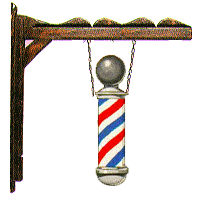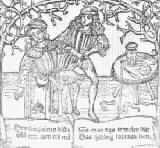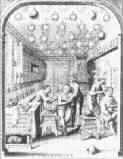



Explore Barber/Surgeon Links Outside of Guild Hall
Enchante. I am Ambroise Pare, a French barber-surgeon. I have stopped off here at Guild Hall to recruit some apprentices for our Barber/Surgeon Guild. Pardon my ragged appearance but I have just come from treating wounded soldiers. I am developing an alternative to cauterizing a wound (sealing with a red-hot iron) which seems to prove much more effective. My technique is to tie up bleeding arteries with a ligature (a cord) and apply dressings. I am most anxious to teach my new techniques to my new apprentices. But first, I am obiliged to tell you a bit about our profession.
Originally physicians, apothecaries, and barber/surgeons all belonged to the same guild. However, during the Renaissance, they split into seperate groups. Apothecaries and barber/surgeons formed their own seperate guilds and the physicians formed the College of Physicians. This resulted in the medical practice becoming more carefully regulated by law throughout Europe. Penalties are now prescribed for persons who practice medicine without a medical degree which usually takes four years to attain. We surgeons are better off joining with physicians, however in many of the towns throughout Europe we are still associated with barbers in the guild. However I hear that in Sicily laws are being passed to make doctors study medicine for five years before applying for official licenses to practice. No physician is allowed to prognose a grave disease except by consultation with a colleague. In Venice they have legislation which requires physicians and surgeons to meet once a month to exchange clinical notes. Legislation also requires physicians to attend a course on anatomy at least once a year in order to keep their knowledge up to date.
In France, authorities have drawn a fine line of distinction between academic surgeons (surgeons of the long robe) and barber surgeons (surgeons of the short robe). There is even talk of admitting the barber surgeons into the faculty of the University of Paris. In fact, one of their great surgeons, Ambroise Pare, began as a barber surgeon.
Representatives of the physicians and surgeons petitioned the mayor of London in 1422 for recognition of their newly formed guild. In their petition they outlined a set of rules by which they would govern their members, which also included apothecaries. Some of those rules were:
When you graduate from medical school, you will be required to take an oath to never protract the sickness of a patient. You must also swear to supervise the preparation of your prescriptions and never take a part of the price charged by the apothecary for filling them.

 You may have
noticed our symbol we use to identify our guild. It comes from our legacy
of practicing bloodletting (JPEG-66k).
To perform the operation we had a staff for the patient to grasp so the
veins on the arm would stand out sharply, a basin to hold leeches
(JPEG - 44k) and catch blood, and a large supply of linen bandages. We would
hang the bandages on the staff to dry after the operation. The wind would
twirl the linen bandages and form the red and white spiral pattern. That
is why we have the stripes on the pole. The ball on top comes from the practice
in the past of topping the pole with a leech basin.
You may have
noticed our symbol we use to identify our guild. It comes from our legacy
of practicing bloodletting (JPEG-66k).
To perform the operation we had a staff for the patient to grasp so the
veins on the arm would stand out sharply, a basin to hold leeches
(JPEG - 44k) and catch blood, and a large supply of linen bandages. We would
hang the bandages on the staff to dry after the operation. The wind would
twirl the linen bandages and form the red and white spiral pattern. That
is why we have the stripes on the pole. The ball on top comes from the practice
in the past of topping the pole with a leech basin.
But enough of my talk. You should really talk to many people to learn about the surgeon's role in these times. I know of many who would gladly speak with you. Here, I will give you a list of their names and where you may find them:
[Note: To return to Guild Hall use the "Back" function of your browser.]
Durant, Will (1953). The Renaissance: A History of Civilization in Italy from 1304-1576 A.D. Simon & Schuster. New York, New York.
Lyon, Sue (Ed.) (1989). Shakespeare's England. Marshall Cavendish, New York, N.Y.
Newman, Art (1988). The Illustrated Treasury of Medical Curiosa. McGraw-Hill, Inc. New York, New York.
Wood, Tim (1993). The Renaissance. Viking Press, New York, N.Y.